 |
|
 |
May 2012 |
 |
|

|
 |
Feature Article
|
 |
 |
Battery Management Considerations for Large Cell Count Systems
Karthik Kadirvel, Design Engineer • Texas Instruments
Over the last few years there has been an increased use of lithium-ion (Li-Ion) batteries in high-power applications such as power tools, yard tools, uninterruptible power supplies (UPS) and hybrid electric vehicles (HEV), which traditionally have been served by ...read more
Flywheel Energy Storage – A UPS Battery’s Best Friend
Dann McKeraghan, Vice President • VYCON
In today’s mission-critical facilities, the role of the uninterruptible power system (UPS) has changed from providing enough back-up time to shut down IT systems safely to one of providing a “bridge” to a facility’s diesel generator-set for continuous power availability. Traditionally, facilities have depended upon UPSs with valve-regulated lead-acid (VRLA) batteries to provide ...read more
|
|
 |
 |
| |
Sponsored Announcement |
 |
 2012 Battery Power Resource Guide 2012 Battery Power Resource Guide
The premier guide to the Battery Industry will be available in less than 2 months. The 2012 Battery Power Resource Guide will include detailed product/service listings in various segments of the battery market, in an easy to use format. The guide will be available in print & digital format, and will be placed prominently for a full year at www.batterypoweronline.com.
Deadline May 31st!
Included Categories:
Accessories, Battery Packs, Battery Types, Cables/Harnesses, Charging, Components, Enclosures, Integrated Circuits, Materials, Manufacturing, Monitoring, Power Supplies, Recycling, Safety Systems/Equipment, Testing Systems, Testing Services, UPS Systems + more!
Profile Opportunities:
- Deluxe Company Profile: $1395 (Includes company logo, 100 word description, contact info, profile listing in 2 product/service categories).
- Enhanced Company Profile: $450 (Includes company logo, 30 word description, contact info, profile listing in 1 product/service category).
- Basic Company Profile: $250 (Includes 30 word description, contact info, profile listing in 1 product/service category).
To purchase a profile, or to view the 2011 Battery Power Resource Guide, visit this link: http://www.batterypoweronline.com/resourceguide.htm
For questions about placing a full page, ½ page, 1/3 page, or ¼ page advertisement, please contact Jeremy Fleming. JeremyF@infowebcom.com or 720-528-3770 ext. 121.
|
 |
 |
| |
New Products |
| |
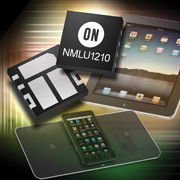 ON Semiconductor Introduces High Efficiency Wireless Charging ICs ON Semiconductor Introduces High Efficiency Wireless Charging ICs
ON Semiconductor has released the NMLU1210, a power MOSFET integrated circuit (IC) for wireless charging applications in portable products such as cell phones, media tablets, portable media players, digital still cameras and GPS units.
The NMLU1210 is a 20 volt (V) N-channel full bridge semi-synchronous rectifier, that incorporates a dual Schottky barrier diode supporting up to 3.2 ampere (A) operation plus two MOSFETs with a 17 milliohm (mΩ) (typical) Rds(ON) to minimize conduction losses and increase efficiency of the charging system.
Wireless inductive charging is becoming increasingly popular, freeing consumers from the inconvenience of the traditional wired approach. It works on the principle of an electromagnetic field being created for the rapid transfer of energy between the transmitter (in the charging station) and the receiver (in the portable device). The NMLU1210 is used by the receiver side to convert AC voltage generated by the transmitter to DC voltage used for battery charging. Offered in an ultra-low inductance thermally efficient package, it is optimized specifically for power management tasks in portable electronic products. This IC is highly suited to use in space-constrained environments. It has an operational junction temperature of -55°C to 125°C.
The NMLU1210 is offered in a 4.0 mm by 4.0 mm by 0.5 mm µCool, RoHS-compliant package. The device is priced at $0.70 per unit in 10,000 unit quantities.
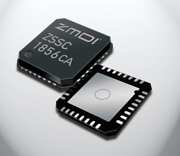 ZMDI Launches Intelligent Battery Sensor IC for Automotive, Industrial and Medical Markets ZMDI Launches Intelligent Battery Sensor IC for Automotive, Industrial and Medical Markets
ZMD AG (ZMDI) has announced the ZSSC1856. As a global supplier of analog and mixed-signal solutions for automotive, industrial, medical, information technology and consumer applications, ZMDI introduces the first member of a new Battery Power Management product line. The ZSSC1856 features two high-precision 18-bit Sigma/Delta ADCs with an on-chip voltage reference. Designed for ultra-low power consumption, the ZSSC1856 uses less than 100 μA in Sleep Mode and comes in a PQFN32 5 mm by 5 mm package 0.85 mm high.
Originally designed for automotive applications such as start/stop systems, the ZSSC1856 lends itself to industrial and medical systems that require precise battery state-of-health (SOH), state-of-charge (SOC) or state-of-function (SOF) monitoring, such as emergency lighting, uninterruptable power supplies, hospital equipment and alarm systems.
The ZSSC1856 is a dual-channel ADC with an embedded microcontroller. One of the two input channels measures the battery current IBAT via the voltage drop at the external shunt resistor. The second channel measures the battery voltage VBAT and the temperature. An integrated flash memory is provided for customer-specific software. The device communication interface supports LIN 1.3, 2.0 and 2.1 specifications. The ZSSC1856 is AEC-Q100 qualified and specified for temperatures from -40°C to 125°C.
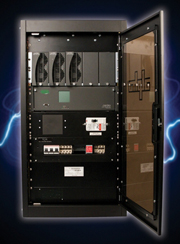 Alpha ACS Series Helps Customers Take Charge of Industrial Powering Needs Alpha ACS Series Helps Customers Take Charge of Industrial Powering Needs
Alpha Industrial Power (AIP) offers a new and flexible, highly efficient battery charging solution with the addition of the Alpha Charging System High Performance (ACS-HP) series. The ACS-HP series is capable of charging multiple types of stationary batteries, primarily for industrial, petrochemical and utility applications. The series combines an extremely low ripple output and greater than 93 percent efficiency to make for lower operating costs. Five hot swappable Cordex 4.4 kW rectifiers are stored in a compact 4RU shelf, providing immense power in a compact space.
"The ACS-HP Series provides efficiency, flexibility and reliability in one system," said Sam Ayoubi, AIP vice president of Sales. "It supports wide input ranges, from 187 to 312 VAC single phase to 208 to 480 VAC three phase, and systems are expandable with power options up to 800 A. In addition, the Cordex monitoring and control package is unparalleled in today's market.
The Cordex monitoring and control package provides complete access to battery management, data logging, daily statistics and charger system control. The CXC touch screen or Ethernet connection and internet browser enable simple adjustment and control, regardless of local or remote setup.
|
| |
Industry News |
| |
Infinite Power Solutions Demonstrates Record-Breaking 75,000 Full Battery Cycles
Infinite Power Solutions, Inc. (IPS) has achieved record-breaking cycle life performance of 75,000 full battery cycles on production cells, substantially beyond that of any other lithium-based rechargeable battery currently on the market. The announcement marks a new technology milestone for the rechargeable battery industry as IPS demonstrates the significant recharge capabilities of its paper-thin and eco-friendly THINERGY Micro-Energy Cell (MEC) products. Moreover, this latest achievement further validates how powerful and long-lasting MECs represent a transformational technology that fundamentally changes the way power source for wireless sensors and other micro-electronic products can and will be designed in the future.
After more than two years of testing, IPS reports it has demonstrated cycle capability of 75,000 full depth of discharge (100-percent DoD) battery cycles at 25°C with a 10°C-rate discharge and 6 C-rate recharge, maintaining 65 percent of the initial capacity, as verified at the capacity-defining 1/2 C-rate discharge. The company tested production 0.7 mAh, one square-inch rechargeable cells, one of the largest cells in the THINERGY MEC standard product family. During the same test and under the same conditions, 40,000 cycles were demonstrated with 80 percent of the capacity maintained. In comparison, other rechargeable batteries, such as Li-Ion, Li-polymer and NiMH cells, are usually cycled at 25°C to 100 percent DOD and typically achieve around 500 cycles with 80 percent capacity retention. Therefore, THINERGY MECs have been demonstrated to cycle more than 80 times than that of traditional rechargeable batteries.
IPS' THINERGY MECs are high-performance 4 V energy storage devices that deliver high energy density, high current and unprecedented cycle life in a 170 µm thin form factor. These MECs provide an alternative to bulky and short-lived conventional batteries and supercapacitors in applications where minimum volume, maximum energy density and long service life is critical. When combined with circuits that harvest ambient energy, THINERGY MECs can be perpetually recharged to power wireless sensors and other low-power devices, providing an inherently safe and sustainable clean energy source that will last the life of a system with no maintenance or replacement cost.
Metal Conversion Technologies Creates Important Consumer Safety Message for Recycling Lithium Batteries
Metal Conversion Technologies (MCT), LLC, the second largest consumer rechargeable battery recycler in North America, is educating consumers on important safety guidelines for recycling lithium batteries. Many consumers are not aware that shipping lithium batteries to recycling facilities without following the Department of Transportation shipping guidelines can result in an explosion and a fire, either during shipping or at the receiving facility.
Metal Conversion Technologies makes it easy for consumers to quickly obtain the Department of Transportation shipping guidelines to ensure proper shipping. By visiting the MCT website at www.metalconversion.com, consumers can watch a video that demonstrates proper shipping guidelines, download step-by-step instructions, and print shipping labels required for easy identification when shipping hazardous materials such as lithium batteries.
"By following some simple steps to prevent the battery terminals from touching during shipment, consumers can help contribute to a healthier environment by recycling batteries, and can ensure that the batteries do not become a fire or explosive hazard," said John Patterson, CEO of Metal Conversion Technologies. "Consumers are doing something good for the environment by recycling batteries, but need to be aware of the simple but effective steps outlined by the DOT to help them feel confident that they are safely recycling batteries."
NRL Charges Marine Corps Expeditionary Power Requirements
Researchers at the US Naval Research Laboratory Electronic Science and Technology Division are working to help the US Marine Corps (USMC) reduce expeditionary energy supply needs and risks and increase the effectiveness of forward deployed forces.
“One of the most significant challenges currently facing the Marine Corps is the need to supply sufficient electricity to individual Marines in forward operating bases,” said Robert Walters, head, NRL Solid State Devices Branch. “Mobile photovoltaics are a technology that can address these needs by leveraging emerging, flexible, high efficiency photovoltaic technology.”
The military’s need to reduce both fuel and battery resupply is a real time requirement for increasing combat effectiveness and decreasing vulnerability. The overarching objective of the USMC Expeditionary Energy Strategy is to increase operational energy efficiency on the battlefield through the combination of on-installation alternative energy production and energy demand reduction. This subsequently is projected to reduce fuel consumed, per Marine, per day, by 50 percent and reduce total weight of batteries carried by nearly 200,000 pounds.
It has been recognized that photovoltaic (PV) cells are essentially the only renewable energy source that can meet this challenge. NRL, in collaboration with MicroLink Devices, Design Intelligence, Inc., and the USMC Expeditionary Energy Office (E2O), have developed and prototyped a new photovoltaic system to meet the unique needs of USMC Expeditionary Power for robust, high-efficiency solar panels suitable for adaptation to rechargeable batteries in the field.
The mobile solar power (MSP) prototype, capitalizing on recent advances in solar cell technology that allow the manufacture of high-efficiency, flexible solar cells, consists of an array of single-junction solar cells with a power conditioning circuit that maximizes array power production and charges a standard, military issue, high capacity rechargeable lithium-ion battery (BB-2590).
Flexible solar cells with light to electricity conversion efficiency as high as 30 percent have been demonstrated in multi-cell panels and although field tests are still in progress, initial modeling, simulation, and experimentation of the nearly 150 square-inch deployed array have shown considerable promise toward future progress, producing more than 11 watts per 1-sun air mass (AM) 1.5 illumination.
Simple Battery Management Could Save Commercial Vehicle Businesses Thousands Every Year According To CTEK
For commercial vehicle operators, breakdowns aren’t just an inconvenience because of the repair costs, they also have a knock on effect that can to lead to missed delivery slots and even greater expenses. However, many breakdowns could be avoided with simple battery management, according to CTEK.
The 24 V batteries work in two 12 V pairs so careful management is particularly important in the CV arena and, if one battery has a different charge level to the other, it can easy, and quickly result in the entire unit needing to be prematurely replaced. By adopting a simple battery management routine using battery testing and a CTEK smart battery charger, these costs, and risks, can be significantly reduced.
Testing has often reveals that batteries require varying degrees of attention but mainly recharging. A fully charged 24 V battery will have a voltage of 25.4 V but, if this level drops below 24.8 V, a process called sulphation will begin to occur, resulting in a drop of the battery’s performance.
The CTEK system deals with the problems that reduce battery life and cause failure, sulphation and stratification, safely and at the touch of a button. CTEK’s charging program goes to work automatically, detecting battery issues and dealing with them systematically to restore power, condition and, at the same time, avoid fluid loss, a major problems with sealed batteries.
“The process of effective battery management has been made even more important following the introduction of stringent emissions regulations. Now, CV’s perform more starts per 1,000 miles and ‘engine off’ electrical system power consumption has also increased, both placing additional strain on the battery.”
With the technology available from CTEK, battery maintenance can become a regular service routine without causing disruption to other maintenance activities, and the benefits in vehicle reliability and cost saving mean that investing in the right equipment will give a return on investment within weeks. However, in the CV sphere a 12 V battery charger very often would not be powerful enough the complete the job effectively so, ensure that a 24 V charger is used.
AES Combines Advanced Battery-Based Energy Storage with a Traditional Power Plant
AES Gener and AES Energy Storage announced the commercial operation of the second energy storage project in Northern Chile, integrating 20 MW of advanced battery-based energy storage with a 544 MW thermal power plant. The project is owned by AES Gener, the second largest power generator in the country, and will operate through its subsidiary, Empresa Eléctrica Angamos S.A.
This project builds on the success of an initial partnership between the two companies, both subsidiaries of the AES Corp., to develop a 12 MW energy storage system integrated with AES Gener’s Norgener power plant. Located at an electrical substation 172 kilometers from Antofagasta, Chile, the Los Andes Battery Energy Storage System (BESS) has been delivering a similar reliability service since 2009.
“As one of the largest power generators in Chile, we’re consistently looking for ways to unlock value of our existing plants while maintaining grid reliability and flexibility,” said Felipe Ceron, CEO of AES Gener. “Since 2009, we’ve been working with AES Energy Storage to free up generating capacity at our Norgener plant by employing a battery-based installation to meet the power system’s obligations for spinning reserve. That project has been in commercial operation for nearly three years, and we’re now applying the service on a larger scale with Angamos.”
Much like a hybrid electric vehicle incorporates a battery component to improve efficiency; combining battery storage with a traditional power plant allows the plant to more effectively use its own generated power while continuing to provide essential spinning reserve services. The advanced reserve capacity provided by the storage technology will enable the Angamos plant to generate an additional 20 MW of energy at virtually all times throughout the year, which would otherwise be tied up to maintain the plant’s grid reliability responsibilities in the case of unexpected transmission loss, the failure of a power generator, or another accident that might otherwise necessitate reduced power to customers. As a result, this newly available energy will increase power generation from the Angamos plant by 4 percent.
Designed, built and operational in fifteen months, the energy storage system provides speed and response to any system reliability event such as loss of transmission, or loss of a power generator. Fast response enables the power system operator to maintain and restore the grid with less shedding of load from customers or other disruptive actions. In 2011, the first 12 MW project in Los Andes was noted by the region’s grid operator, CDEC-SING, as one of the best performing reserve units in Northern Chile.
The Angamos BESS is comprised of approximately one million advanced lithium-ion battery cells, divided between ten 2 MW battery containers, and five 4 MW power controls containers. A123 Systems supplied the energy storage systems for the project. The power controls modules were provided by ABB.
|
| |

|
 |
Event Listings |
 |
 |
 Pre Conference Workshops Provide On-Hands Training at Battery Power 2012 Pre Conference Workshops Provide On-Hands Training at Battery Power 2012
Battery Power 2012 will host pre-conference workshops on Monday, September 17th, providing design engineers with extensive, hands-on training. Seating is limited and early-registration discounts are available.
Lithium-Ion Battery Design Tutorial
Presented by: Robert Spotnitz, Battery Design LLC
This full day course surveys all aspects of lithium-ion battery design ranging from materials and processes, to cells to packs. A thorough overview of the issues involved in life estimation, thermal behavior, and abuse tolerance is provided.
Shipping Lithium Batteries by Air and Ground
Presented by: DGI Training, Inc.
This course is for individuals who are involved in shipping small and medium lithium batteries alone, packed with or contained in equipment, using highway or air transportation.
Battery Power Applications: Safety, Charging, Fuel Gauging, Authentication, and Cell Balancing
Presented by: Jinrong Qian, Texas Instruments
This workshop addresses the issues surrounding battery power applications for safely and efficiently charging the battery, smartly monitoring the battery operations, accurately estimating battery remaining capacity, cell balancing from handheld, laptop, power tools, e-Bike, electric vehicle, to medical applications.
Using Thermal Analysis and Calorimetry in the Design and Testing of Lithium Ions Batteries and Materials
Presented by: Peter Ralbovsky, NETZSCH Instruments North America, LLC
This short course will explain in detail different thermal analysis techniques and how they can be best applied to the material development and full cell testing both for performance and safety.
Tour of the National Renewable Energy Laboratory (NREL)
Presented by: NREL
Attendees will be given a tour of NREL’s Battery Thermal Management Lab at the Thermal Test Facility, the Battery Material Research Lab at the Solar Energy Research Facility and Science and Technology Facility, as well as a tour of the Vehicle Test Integration Facility.
|
 |
 |
|
 |
 |
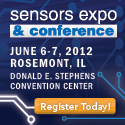 Sensors Expo Sensors Expo
June 6-7
Rosemont, Ill.
Sensors Expo & Conference is the only industry event in North America exclusively focused on sensors and sensor-integrated systems, providing over 25 years of technical innovation and thought leadership! The conference program is dedicated to exploring the most up-to-date innovations in sensor technology, including Big Data, MEMS, Energy Harvesting, Wireless Sensing, Measurement & Detection, and more. Sensors identifies cutting-edge trends, explores them in an information-packed conference program and reflects those trends throughout the Expo with new product announcements, key technology-focused areas, such as Big Data, Energy Harvesting, MEMS and Wireless Pavilions, and a showcase of hundreds of products and services. Special Offer for Subscribers: Register with code A301H in advance at www.sensorsexpo.com to save on conference pass rates!
 TechConnect World 2012 TechConnect World 2012
June 18-21
Santa Clara, Calif.
The TechConnect World is the world's largest multi-disciplinary multi-sector conference and marketplace of vetted innovations, innovators and technology business developers and funders. The TechConnect World houses four world-class technical events focused on advancements in Nanotech, Microtech, Biotech, Cleantech and the technology overlap between these converging domains. As technologies commercially mature from the purely research stage, they are advanced into the TechConnect Summit and partnering programs in which IP and Early-stage companies are reviewed and selected by our board of corporate and investment partners.
Through our events and strategic partners, TechConnect increases the innovation pipeline, helps partners find new licensing and business opportunities, and matches corporate and investment partners to top vetted technologies from around the world.
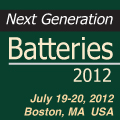 Next Generation Batteries 2012 Next Generation Batteries 2012
July 19-20
Boston, Mass.
Next Generation Batteries 2012 on July 19-20, 2012 in Boston, MA will focus on breakthroughs in new battery chemistries, novel electrode and electrolyte materials, system integration for a vast array of mobile, portable and stationary applications, from micro medical devices to high-energy/high-power automotive, have paved the roadmap for an emerging market with unlimited potential. Will lithium-ion batteries deliver on the promises of power, energy, cost and safety in commercially available systems or does the future lay somewhere beyond lithium-based chemistries? Our panel of leading experts in the fields of battery materials, systems design and integration, manufacturing and commercial applications will look into emerging issues underlining this pivotal time in the battery industry segment.
|
 |
| |
Contact Us |
|
| |
Submit editorial content to Shannon Given at 608-351-9245
For advertising information contact Jeremy Fleming at 800-803-9488 X121
Webcom Communications • 7355 E. Orchard Road, Suite 100; Greenwood Village, CO 80111
Phone: 800-803-9488 • Fax: 720-528-3771 • www.infowebcom.com |
|
| |
© 2012 Webcom Communications Corp. |
|
|
|
|
|
|